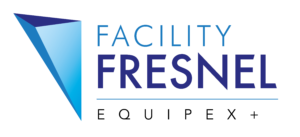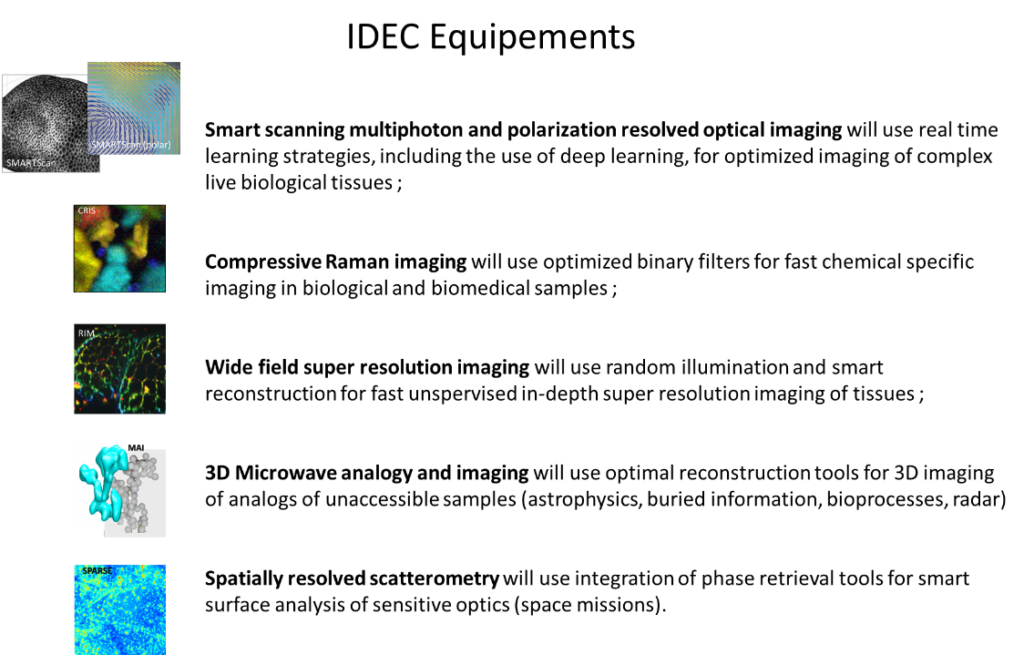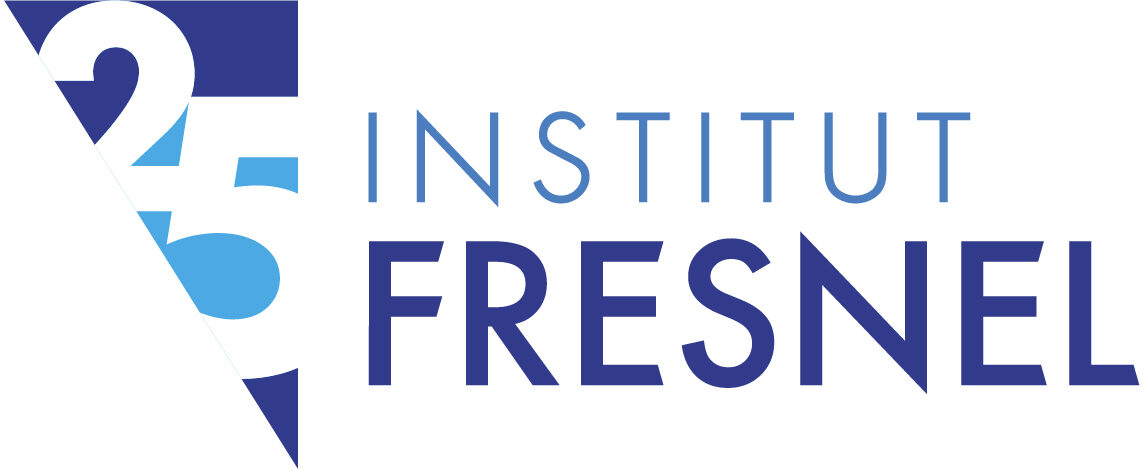
EQUIPEX+ COMPUTATIONAL IMAGING AND DETECTION
Partners : Aix Marseille University (coordinator) & CNRS
Contact : Sophie Brasselet
COMPUTATIONAL IMAGING AND DETECTION

ANR agreement : 18/10/2021
Start / End date : 01/10/2021 – 30/09/2026
PIA grant : 2 327 886 € (including 172,436 k€ in administrative costs)
Total budget : 6 066 661.50 €
The goal of the IDEC project is to provide access to the next-generation imaging and detection systems in optics and microwaves, based on a pure hardware-software co-design which will benefit from the complementary knowledge and experience of researchers and engineers of Institut Fresnel in numerical approaches and instrumentation.
The resulting IDEC platform contains five built-in instruments which exploit the hybridation between digital science and instrumentation to answer today’s needs in imaging and detection, for use in interdisciplinary fields from biology to astrophysics. Research and innovation in optical and microwave imaging or materials characterization face common challenges with low signal to noise conditions, high speed measurements conditions, as well as issues in information reconstruction due to inevitable limitation in the amount of data available. The IDEC instruments will answer these challenges by bringing together algorithmic and applied mathematical developments including artificial intelligence, within imaging and detection systems. We will bring our most mature approaches to the level of an open platform internationally recognized, where practical applications in imaging and detection can be solved thanks to this hybridation.
Collaborators and users of IDEC are from a highly interdisciplinary context, covering biology, biomedical sciences, environment, material sciences, astrophysics, spatial explorations and industrial applications such as pharmaceutical, cosmetics and utilitary networks detection. Development and running of the equipment will be done at Institut Fresnel, following the model of existing platforms.
IDEC will involve 13 researchers and 8 engineers from Institut Fresnel during the two first years of implementation, during which both numerical and instrumentation developments will be operated in a concerted way with complementary expertises. For the three next years of running, 6 researchers and 4 engineers will be involved for maintenance, co-development and access to users and collaborators.
During these phases and after, IDEC will be an ideal environment to train Master, PhD students and postdoctorates in connection to local training programs in photonics (Europhotonics master) and Signal and Image Processing (TSI master). The instruments will be open to both academic (laboratories) and non-academic sectors (industry, large instruments, large organizations), involved through co-funded collaborative projects, co-development projects governed by well defined IP rules including technological transfers and startup creations, as well as use by pricing following the system already in place in other Institut Fresnel platforms.
The sustainability of IDEC will be based on these different schemes and is expected to create engineer positions that will be operational for the running of the platform. This project is part of key strategical research and innovation directions at different levels : at the local level, through the Excellence Initiative A*midex initiated by Aix Marseille University, in particular within the newly created institutes (Marseille Imaging among others) and through training in reseach in existing masters (Europhotonics,TSI) and doctorate programs (Physics and Science de la Matière) ; at the national level, through national strategy directions such as defined by Agence Nationale de la Recherche in health, material sciences and numerical tools including artificial intelligence ; at the European scale, where photonics and advanced materials are part of the key enabling technologies that are considered to strengthen Europe’s industrial capacities.

CONTACTS :
Coordination : Sophie Brasselet – Scientific & Technical Manager
Instrumentation :
– SMARTScan : Loïc Le Goff (imaging) & Sophie Brasselet (Polarimetry)
– µWAI : Jean-Michel Geffrin
– CRIS : Hervé Rigneault
– RIM : Anne Sentenac & Loïc Le Goff – developed in collaboration with Thomas Mangeat, CBI Toulouse
– SPARSE : Myriam Zerrad
Numerical Approches : Anne Sentenac (reconstuction) & Amélie Litman (co-conception)
Administration : Ouissal Touila – Financial Manager
Communication : Claire Guéné – Communication Officer
PUBLICATIONS
– C Grand, C Scotté, H Rigneault, Fast Compressive Raman Imaging of Polymorph Molecules and Excipients in Pharmaceutical Tablets. Analytical Chemistry 94 (48), 16632-16637, https://doi.org/10.1021/acs.analchem.2c02680
– S. Heuke, X. Audier, H. Rigneault, ‘Double-modulations stimulated Raman scattering : how to image up to 16-fold faster’, Optics Letters 48, 423-426 (2023), https://doi.org/10.1364/OL.467514
– F. El Moussawi, M. Hofer, D. Labat, A. Cassez, G. Bouwmans, S. Sivankutty, R. Cossart, O. Vanvincq, H. Rigneault, and E. R. Andresen, “Tapered Multicore Fiber for Lensless Endoscopes,” ACS Photonics (2022), https://doi.org/10.1021/acsphotonics.2c00661
– D. Septier, V. Mytskaniuk, R. Habert, D. Labat, K. Baudelle, A. Cassez, G. Brévalle-Wasilewski, M. Conforti, G. Bouwmans, H. Rigneault, and A. Kudlinski, “Label-free highly multimodal nonlinear endoscope,” Optics Express 30, 25020-25033 (2022), https://doi.org/10.1364/OE.462361
– Adrien Bolliand, Edith Hartmann, Michel Lequime, Myriam Zerrad, Claude Amra. A new spatially and angularly resolved scatterometer. Optical Interference Coatings, Jun 2022, Vancouver, Canada. pp.ThB.7, 〈10.1364/OIC.2022.ThB.7〉. 〈hal-03829164〉
– Adrien Bolliand, Myriam Zerrad, Michel Lequime, Claude Amra. Spatially resolved scattering metrology to quantify losses induced by contamination and defects. ICSO 2022, Oct 2022, Dubrovnik, Croatia. 〈hal-03829307〉
– Burcklen, Galland, Le Goff (2022). Optimizing sampling for surface localization in 3D-scanning microscopy. JOSA A. doi : https://doi.org/10.1101/2022.03.21.485110
– Rigato, Meng, Abouakil, LeGoff (2022). Compaction of Drosophila histoblasts in a crowded epidermis is driven by buckling of their apical junctions. BioRxiv, DOI : 10.1101/2022.02.10.479869
– Meng, Nuzdhin, Sison, Galland, LeGoff (2022).Adaptive scans allow 3D-targeted laser-dissection to probe the mechanics of cell sheets. BioRxiv. 10.1101/2022.01.30.478374

